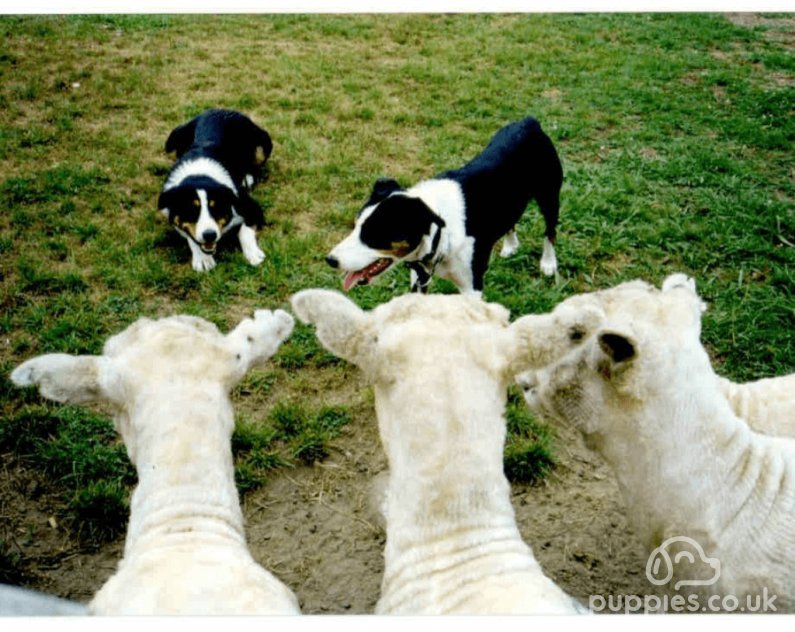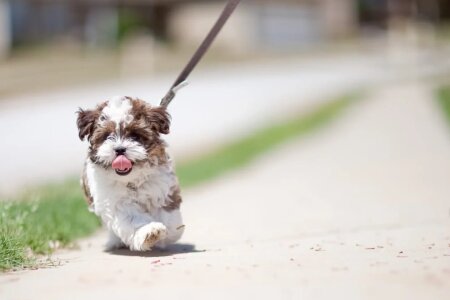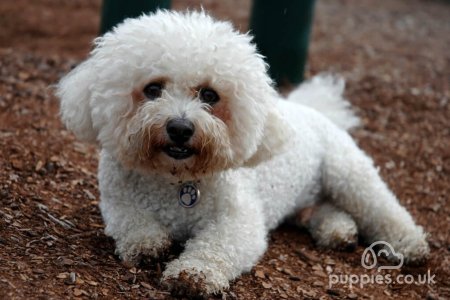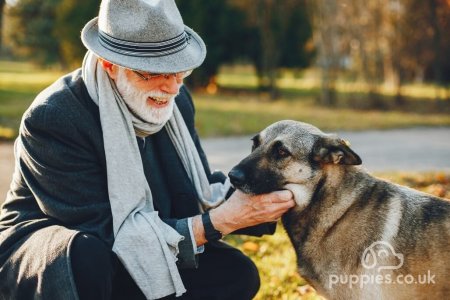Herding Breeds and Their Behaviour

Dogs have retained many behaviours from their ancient ancestors, the wolf! Traits, such as how they respond to something scary or their predation behaviours, have their origins with these descendants. The amount of prey drive, their desire to chase and capture prey, varies greatly from breed to breed and from dog to dog within a breed. Genetics play the major role in this, so it is important to get enough information about both parents when purchasing a puppy. Prey drive is a sequence of events which can be seen in the wolf today, the complete predatory sequence is:
- Orient
- Eye
- Stalk
- Chase
- Bite Hold
- Bite Kill
- Dissect
- Consume
Many of the herding breeds, such as Border Collies, Australian sheepdogs and the Shetland Sheepdog, have a strong instinct to do the work they were bred for - control livestock. The breed I am attracted to is the Border Collie, and you will know why when you see a good sheepdog doing the work they love. The focus, the response and the sheer joy they have, putting the early parts of the predatory sequence into practice, orient, eye, stalk and the chase, is so amazing to watch! Some over excited herders, and those herding cattle like the Australian Cattle Dogs, will nip as they are faced with some of the more stubborn animals to move. As a result of this behaviour, nipping at the heels of the livestock, they are sometimes called ‘Heelers’. This behaviour is not always a good trait for a sheepdog, as it can scare the pants out of the sheep! There is also another reason why this is not a desirable trait as if they break the skin, the sheep are then prone to infection. Thankfully, this is as far as the predatory sequence goes for the herding breeds, seldom do they attack or kill livestock.
Herding breeds are generally athletic and intelligent, meaning they need both physical and mental challenges to keep them sane. To own a herding breed, you need to have an active lifestyle and be committed to more than just walks to satisfy their needs. If you don’t give these dogs what they need, you may hit some of the behaviour problems they can develop as a result of them becoming ‘self-employed’. “If you don’t employ a dog, they will become self-employed”, is a phrase I often use with my clients. It applies across all breeds for those most active and needing to put their intelligent to good use and, typically, owners do not like the jobs their dogs employ themselves with.
Herding breeds were bred to do a job which would take up most of their day, meaning they naturally have good stamina and high energy levels. Even if they are not to be employed to herd livestock, it is important that the herding instinct of such breeds is satisfied in some way. The good news is, they will adapt to many different types of jobs and can easily be motivated to participate in activities that you can enjoy too!
There are several ways to keep your canine companion constructively occupied. If your interests are in physical pursuits, you may enjoy agility, canicross or working trials. You may choose to utilise their sense of smell, employing them in scent and search activities. If you do not want to put their herding instinct to use with livestock, there is always treibball, which involves ‘herding’ large inflatable fitness balls into a football like goal! However, remember that on livestock they learn how to make decisions based on what the livestock is doing too, so they will also need the chance to put their active minds to use. My personal passion is for precision activities, like obedience or freestyle, because the depth of the relationship that develops is truly unbelievable.
These breeds make great pets as they are loyal and love working in partnership with their human counterparts. They are always up for doing something, no matter what time of day it is, making them an ideal companion.
You cannot stop the mind of a herding breed. If you choose to own one of these breeds, you need to have empathy with their desire to do things and sympathy with their sensitivity, which can easily result in over arousal, and their slightly obsessive behaviours. Understanding and utilising these traits, enables you to prevent certain behavioural problems which commonly present in these breeds.
There is variation between the herding breeds and remember that each dog has its individual personality. I cannot recommend highly enough purchasing your puppy from a good breeder who has a socialisation program in place, similar to the one in the article ‘Top things to check your breeder is doing for socialisation’ (provide link to this article). Following the advice given in that article, will ensure your puppy is behaviourally and emotionally healthy. I would not recommend purchasing a herding breed which has been raised in an outdoor area, with little exposure to novel experience, who has not received close, varied human contact. It is likely that their instincts will have been put to good use already, making the future difficult for even an experienced trainer.
EARLY TRAINING
Many herding breeds, especially the Border Collie, are intelligent and can be mentally complex. These traits, combined with the high energy levels, means they can easily respond with an emotional overreaction, negating the intellectual side of their brains and appearing quite blinkered in their responses. They are capable of making sensible decisions and this skill needs to be nurtured in them.
Employing some early calming strategies and beginning to establish communication between you, will be key to your success. Most herding dogs are busy, busy, busy, so you need to be mindful and learn to recognising signs of overtiredness. It is common for arousal levels to increase which may present itself in many ways, commonly an increase in the desire to eye, stalk and chase. Having some tools and techniques and calmer activities to engage the puppy such as nose work will enable you to bring arousal levels to a more suitable place to encourage the puppy to sleep.
Some of the behaviours that will come out when herding breeds are over stimulated are chasing, circling, nipping, poking and barking. These behaviours may be directed toward any movement in the environment, whether that is your kids, cars or joggers. All movement can be seen as fun when they are in this mindset, so environmental soundness, their confidence and receptivity in a variety of environments, is the number one area for your training. Noise sensitivity is another stimulus herding breeds can be sensitive to, work at greater distances when combining this with movement to ensure your puppy builds confidence and you are on the right path for creating a ‘so what’ response.
To ensure success, always do environmental work when your young herder has had some sleep and in the right mindset for learning. Distance between your dog and the stimuli is always your friend, so expose them to movement at distances, where they can watch, without getting overstimulated. If you can create some calm emotions prior to this exposure, then great, you have some tools to work with. Calm emotions might be achieved using a chill out mat, where you relax together, or a calm and happy emotion when in their crate, which you can then utilise in early exposures, between 8-12 weeks. My online training course provides detailed information on the stages you need to work through to achieve calm, confident emotions in your dog, in stimulating environments. It also gives details of other tools and techniques you might employ alongside this skill, to enable you to redirect their attention so you get that “So What” response to environmental movement in the future. ‘So What’ there is a noisy fast car, ‘So What’ there are geese on the field’.
Keeping training sessions short means effective learning is more likely to take place. You should aim to keep them engaged throughout the session so that you build a good training history. I believe it is a good thing leaving them wanting more, in the nicest possible way, rather than having them make the decision to disengage. I want them to find the time they spend with me more interesting than the self-employed activities they might choose to do.
It is so easy to bring out the prey drive in herding breeds and easy to send them into over arousal with movement, tug and balls game. Of course, they need play, but be careful. Always have an awareness of their emotional mindset. Learning to work with you to obtain a reward, rather than pursuing repetitive actions such as throwing a ball, is going to be much healthier for your future together.
I am passionate about using a marker for correct behaviour (a short word or a clicker) to be able to communicate with my dogs effectively. This is invaluable when it comes to steering emotions in the right direction and achieving that ‘So What’ response. A must for these breeds living in a non-traditional environment for which they were bred.
Learn more with our full training course HERE











